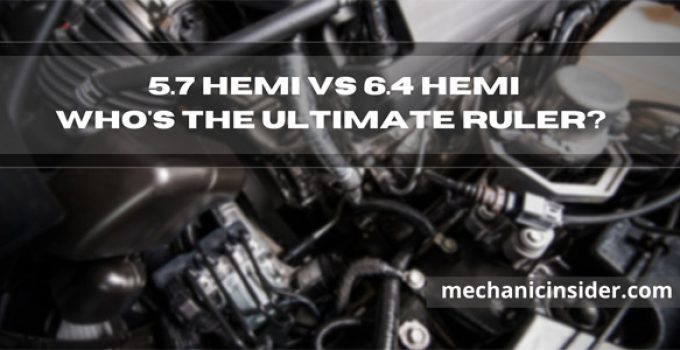The Hemi 5.7 and the Hemi 6.4 engines are both third-generation V8 gasoline engines built by Chrysler. They came to be known as such because of their hemispherical combustion chamber. But even though the third-generation engines are no longer completely hemispherical, the name stuck.
Many of us are on the fence whether to invest in the Hemi 5.7 engines or the 6.4 ones. Now, we all know that we should make every decision by first weighing up our options. And when it comes to automobiles, we should scrutinize even more. So, let us get to know about these engines more, and then we can come to a decision.
Hemi 5.7 Engine
Chrysler started their third-generation Hemi engines with the kick-off of the Hemi 5.7 engines in 2003. They introduced the 5.7 Hemi engine to replace the 5.9L Magnum.
Chrysler’s Hemi 345 engine was a completely new engine, and they built it from scratch. Its cylinder block is made of cast-iron and had a deep-skirt design. There is also an angle of 90 degrees between the cylinder banks. Four bolts per primary bearing support the nodular cast iron made crankshaft. The engine comes equipped with an MDS system. But this feature is not included in manual-transmission vehicles.
The 5.7 Hemi was revised in 2009. Variable-valve timing was introduced in the revised version. Before the revision, the engine featured pistons with wider rings of 1.50/1.50/3.00 mm. After the modification, they were made into smaller ones of 1.20/1.20/2.00 mm. It sports a relatively longer timing chain because the camshaft is intentionally raised, so the length of the pushers could be shortened to create less inertia.
Peek Under the Hood
This part is for those enthusiasts who want to know what the engine can do. Let us not wait any longer and go into the sweet details.
The Hemi 345 engine uses a bore with a diameter of 99.49mm or 3.92 inches and has a stroke with a length of 90.88 mm or 3.58 inches. It has an engine displacement of 345 cubic inches and hence the name Hemi 345 engine. The non-revised version had a compression rate of 9.6 to 1, whereas the revised version has a much better compression rate of 10.5 to 1 and is available in the models from and after 2009.
Now the part that we have all been eagerly waiting for. The horsepower for 5.7 Hemi ranges from 340 to 395 horsepower and offers a torque of 375 to 410 ft-lb.
Compatible Models
- 2003-Present Ram 1500/2500/3500
- 2004-2009, 2011-Present Dodge Durango
- 2005-2008 Dodge Magnum (R/T)
- 2006-Present Dodge Charger (R/T)
- 2009-Present Dodge Challenger (R/T)
- 2005-Present Chrysler 300C
- 2005-Present Jeep Grand Cherokee
- 2006-2010 Jeep Commander
- 2007-2009 Chrysler Aspen
Advantages
Reliability: The 5.7 Hemi engine has no noteworthy design flaws and is very reliable.
Combustion Efficiency: The third-generation Hemi engine has a much better combustion efficiency than all the V8 engines.
Life Expectancy: The 5.7 Hemi engine is expected to live for at least 250 thousand to 300 thousand miles. If we take proper care of it, it can be driven even longer.
Environment Friendly: Chrysler revised the 5.7L Hemi to be much more environmentally friendly and efficient.
Disadvantages
Low-end Torque: The Hemi 345 engine lacks a low-end torque that is needed for towing and hauling for optimum engine performance.
The Tick: The 5.7 Hemi engine users experience a strange ticking sound from the valvetrain owing to its MDS system. But, do note that the ticking sound does not affect anything
MDS Sensitivity: The MDS is susceptible to the condition of the oil, so it is necessary to use only the recommended oil.
Replacement Expense: The Hemi 345 comes with 16 spark plugs that require replacement every thirty thousand miles that can be very expensive.
Hemi 6.4 Engine
The 6.4 Hemi engine was first introduced in 2005, and later Chrysler introduced a production version of the crate Hemi 392 charger in the 2011 Dodge Challenger SRT8. It is more suitable for towing and hauling than its alternative option, the 6.7L ISB Cummins.
The 392 Hemi is also built around a cast-iron, 90-degree cylinder block that includes a deep-skirt design. This engine features a crankshaft made of forged steel. The 6.4 Hemi engine sports piston cooling jets that spray oil on the bottom of the pistons to remove the additional combustion heat.
Peek Under the Hood
Now, let us get down to knowing the 6.4 Hemi Specs. Although the 6.4L Hemi uses the same type of engine block as the 5.7, they share neither the stroke length nor the bore diameter. The 392 Apache uses bores with a 103.90 mm or 4.09 inches diameter and has a stroke with a length of 94.6 mm or 3.72 inches. The Hellcat engine also uses the same bore. Its name, 392 Apache, comes from its engine displacement that you can most probably guess is 392 cubic inches.
The 6.4 Hemi engine has a compression ratio of 10.9 to 1 in the Hemi SRTs and a compression ratio of 10.0 to 1 in the Ram motors. This Dodge engine offers a powerband from 366 HP to 485 HP and features a torque of 429 to 475 lb-ft.
Compatible Models
- 2015-2018 Dodge Charger
- 2015-2018 Dodge Challenger SRT 392 (R/T)
- 2011-2014 Dodge Challenger SRT 8
- 2014-Present Dodge Ram 2500 Pickup
- 2015, 2017-Present Dodge Challenger SRT
- 2016-2017 Ram 2500
- 2016-2017 Ram 3500
- 2018-Present Dodge Ram 3500 Pickup
Advantages
Reliability: Just like the 5.7, the 6.4 Hemi ram version is also a very reliable crate engine.
Power and Torque: The 6.4 Hemi engine offers more horsepower and torque than a member of the same generation, the 5.7 Hemi.
Low-end Torque: The 6.4 provides more torque at a lower range with an additional 70 lb-ft of torque at low-end.
Combustion Chamber Temperature: The new 6.4 engine features piston cooling jets that keep the combustion chamber’s temperature consistent.
Life Expectancy: The 392 Apache is built to last, and we can expect them to run for around 300 thousand miles.
Disadvantages
MDS Solenoid Fail: Many of the earlier models seem to face this problem. It results in the engine running rough.
The Tick: Just like the 5.7 engine, a ticking noise can be heard coming from the valvetrain. Similarly, the tick does not affect anything.
Transmission: Ram 6.4 Hemi problems are usually this one. The engine seems to downshift from second gear to first gear while towing or hauling heavy loads up steep slopes.
5.7 Hemi Vs. 6.4 Hemi - Comparison of Factual Data
Now that we know about both the Hemi 345 and 392 Apache in detail, we can now make an informed decision between the two third-generation Hemi engines.
Let us take a look at the 5.7 Hemi Vs. 6.4 Hemi specs.
Stroke Length
The 5.7 Hemi engine has a stroke length of 90.88 mm (3.58 inches), whereas the 6.4 Hemi engine has that of 94.6mm (3.72 inches). We all know that the longer the stroke, the better. The longer stroke allows the 6.4 to deliver more power than the 5.7 Hemi.
Engine Displacement
The more the engine displacement, the more air and fuel an engine can take into its combustion chamber that, in turn, delivers an increased amount of power output. In terms of engine displacement, the 5.7 Hemi engine has an engine displacement of 345 cubic inches, whereas the 6.4 Hemi has that of 392 cubic inches.
Compression Ratio
A higher compression ratio usually refers to a higher efficiency of the combustion chamber. The 392 Apache engine has a compression ratio of 10.9 to 1, whereas the Hemi 345 engine sports that of 10.5 to 1.
Engine Weight
One of the main complaints that the users usually make about the Hemi engines is their weight. While neither of the machines is very light but between the two of them, the 6.4 engine is slightly on the lighter side with a 227 kg weight, whereas the 5.7 Hemi engine weighs at a staggering 254 kg.
Horsepower
Most of us expect and enjoy a higher horsepower in our vehicles as they give us a sense of freedom. In a comparison between the 5.7 Hemi Vs. 6.4 Hemi horsepower, the 392 apache has a powerband of 366 to 485 HP, which is more than what the 5.7 Hemi horsepower ranges from 340 to 395 HP.
Torque
It is common knowledge that the better engine produces ample torque at low RPM. As we have already seen, the 5.7 engine does not produce a sufficient amount of torque at a low end, whereas the 6.4 engine can do so.
Verdict
Now that we have researched and then compared notes about the 5.7 Hemi engine and the 6.4 model, we can now finally make an informed verdict about who is the ultimate ruler between the two.
As we can clearly see from the comparison above, the 6.4 engine dominates the 5.7 engine in terms of stroke, cc, horsepower, torque, and overall performance. Even in the physical sections such as weight, we can declare the 6.4 engine to be the ultimate ruler!
Final Words
We do have to note that, even though the 6.4 engine has come out as the winner of the competition between the two, both of them are wonderfully built machines, and choosing either one of them should be totally based on their applications and usage. We hope this concise discussion about the two engines can help you make that choice.




a2005 Ram 1500 with a 5.7 Hemi with 210,000 miles on it. I tow a 28 foot travel trailer with it. A little boost in power would be very nice. Would it possible and what the cost be like to go a 6.4 Hemi?